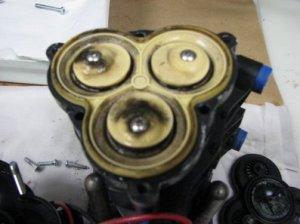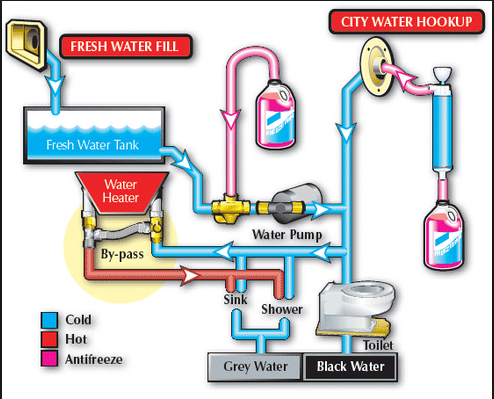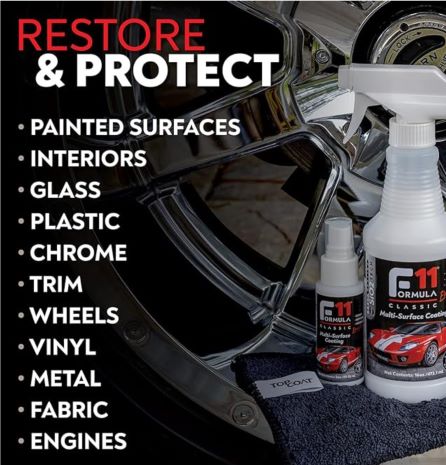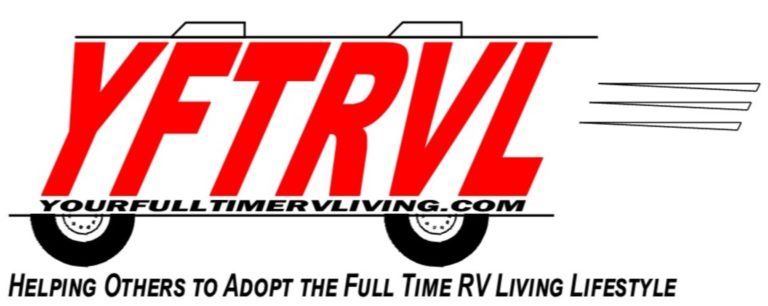Water is a precious commodity! Clean and safe drinkable water is your lifeblood. That is why it is so important to consider sanitizing RV fresh water tank!
But, another important issue to consider here is the longevity of the RV water pump. Without proper maintenance it will not last as long as it should.
I have already discussed on this website about the importance of cleaning the RV water pump screen in order to troubleshoot possible reduced water flow from the pump. The second issue can also be bacteria contamination from an RV water tank and the RV water system.
Sanitizing RV fresh water tank is so important, not only for having safe water to use within your RV, but to keep your RV water pump functioning at its best. Operating your RV water pump with a contaminated water system can slowly destroy your pump over time. If you are noticing a sulfur or rotten eggs type of smell, you may need to consider sanitizing RV fresh water tank as a way to eliminate this problem!

Bacteria Growth Forming on the Inner Workings of an RV Water Pump
Sanitizing RV Fresh Water Tank
This is a fairly simple process, and there are several different methods you can use when sanitizing RV fresh water tank. I think this is one of the simplest that I have come across, and it is recommended by the folks at SHURflo water pumps.
To start, be sure your RV is unhooked from the city water supply and the RV fresh water tank is no more than half full. Obtain some bleach, and a water pitcher, to mix a water and bleach solution. You will want to add five ounces of bleach for every forty gallons of RV fresh water tank volume. So, if you have a seventy five gallon tank you will be using about nine and a half ounces of bleach.
Once you have the proper amount of bleach and water mixed in your pitcher, use a funnel to pour the bleach and water solution into the fresh water tank from the outside water fill.
If you have a winterizing setup in your RV, and you know how to use it, you can use that to suck the bleach solution out of your pitcher and into the RV fresh water tank. Once you have used either of these methods, fill the RV fresh water tank till it is full with fresh potable water.
Now, go inside your RV, turn on the water pump, and run the water in each faucet till you smell the bleach. Do this for both the hot and cold water. Don’t forget the outside water faucet, if you have one.
Once you detect the smell of bleach from each RV faucet, turn them off. Allow the bleach and water solution to sit in the water supply lines for at least four hours. You may go longer if you desire. If you don’t want to wait that long, double the solution concentration and use the same method, but for only one hour.
A good time to do this is when you are going to take a drive in your RV. As long as you have full hookups when you get to where you are going, you can take advantage of the agitation on the RV fresh water tank as you are driving down the road. That way you can assure sanitizing RV fresh water tank is completely accomplished!
Once the water and bleach has had enough contact time, you can proceed to drain the fresh water tank and fill it again with fresh potable water. Then go back to your RV faucets and run water from the RV fresh water tank to flush out the bleach from the supply lines. Do that for both the hot and cold water until you don’t smell any more bleach. If you really want to be sure, you can also use a water test kit, designed for chlorine detection, to be sure you have safe drinking water.
If you still notice the smell of bleach, or your test kit indicates the presence of chlorine, even after running enough fresh water through the supply lines, from the fresh water tank, you may have to drain and refill the fresh water tank again.
Okay, there you have it! Sanitizing RV fresh water tank is not that complicated and it will assure that you not only extend the life of your RV fresh water pump, but that you will also have safe drinking water.
Blessings in your RV adventures!
Howard and Pam
Please leave a comment before you check out another page! if you found this information useful we would like to hear!
And remember, before you buy a used RV, be sure to have it inspected by a certified NRVIA member!









14 comments
Skip to comment form
Great process. I can do it myself. Got really sick from contaminated water last summer. Emergency room etc. I drink only bottled water now but it’s a hassle to always have on hand. We had let the water sit in tank for several weeks with no chlorine. We were boaters and always put a capful of bleach in the water tank when we filled it. Never got sick. Should have known better.
I will clean it out like you suggest and start over.
Thanks,
Judy W.
Thank you I will use your solution to clean my tank. our problem right now is our water pump will run from outside shower switch, but will not work from inside wall switch. Do you have any ideas? could it be a short somewhere? Thanks for any ideas you can come up with.
Author
Possibly the switch is bad Frances?
I must be missing something. Everything I’ve read says to simply dump the water from your fresh water holding tanks after the allotted time. I’ve recently purchased a 2011 work and play. The only drain I see for the fresh water holding tank is a small (like 5/16) drain valve. My water tank holds 80 gallons.
I’m thinking it will take forever to drain this tank. I can see spending hours at a dump station.
I could turn on my water pump and send the 80 gallons to my grey tank? How long would that take, and how hard would that be on my pump?
I could pull my RV into my drive way and drain it through the valve into buckets, but what do you do with 80 gallons of chlorinated water…..I have a septic tank and can’t dump it in my “sewer”. It would kill all my grass or stain my concrete to just let it flow… I’m lost here. Any help you can give me would be much appreciated!!!
Maybe most RV’s have larger drains??
I have another question…..The former owner says it is ok to drive with the propane refrigerator going. I just wanted to ask if that is correct. I was wondering about after getting to my camp site, then firing up the fridge. Just curious about that open propane becoming a bomb if I had a wreck or something??? Thanks again!!!
Author
Hi Vance!
Thanks for visiting our website!
The small low point drain you are referring to is the one to drain the tank. Yes, it will take some time if you choose that route.
You mentioned chlorine in the water. How much was added to the fresh tank? Unless it was enough to get past 50 ppm I would not worry too much about letting it flow. When we want to drain our fresh tank we use the water. If you can’t do that then run your pump to get it into the gray, or black tank, or both. Again, if the chlorine content is really high it could affect the blade seals on your tank valves.
We have a 1 1/2″ drain on our motorhome. The more you spend the more you get . . . LOL!
Traveling with the propane system operational is a big source of altering opinions amongst RVers. The safety organizations that are attached to the RV industry say it is best to travel with the propane off. We had an RV fire from traveling with the propane on. Even some motorized RV manufacturers will state in their safety recommendations to turn the propane off before hitting the road. It’s up to you who you want to believe. All it takes is one road alligator to take out a propane line and you will have an increased risk of a fire.
Great article. Can a filter be connected in line for fresh water taps?
Author
Hi Mike!
Thanks for stopping by our website!
If you are looking for a filter to create drinkable water from your city water supply, yes there are ways to do that. If you want to filter the water from your fresh water tank, yes you can do that too. You have to understand your RV’s freshwater system and where to install it. I have a dual filter system with a sediment filter in one canister and a KDF/GAC filter in the other for my city water. I also have an inline filter for the fresh tank supply. If you want to install a filter under your sink to create drinkable water at that faucet, you can do that too.
Just bought a used Motorhome and the tanks smell really bad. I have now flushed them out a few times and I will use the bleach next. I need to find the pump you show in your diagram.
Thank you,
Bonnie
Author
Hi Bonnie!
Thanks for stopping by our website!
Be careful using a strong mixture of bleach, or anything too caustic as you will ruin the rubber on the blade seals and then they will leak, or fail. There are tank cleaning products that may help that are designed for RV tanks.
I would be sure there is water in all your p-traps and the roof vents are clear allowing odors to escape and not enter the RV. Also, if you have a studor vent (Google that if unknown) located in the RV, you may need to change that as that can be another source of odors when they fail.
Best wishes and check back and let us know how it turns out!
As we are upcoming newbies at going full time Rving. This has proven to be both eye-opening and educational. Thanks so much for the info on this critical system as a must do item. Mike
Author
Thanks for stopping by Mike!
Best wishes as you begin the full time RV living experience!
very well written and helpful thanks
Thank you. It sounds simple and will get onto it soon.
Author
Thanks for stopping by our website Jim!!